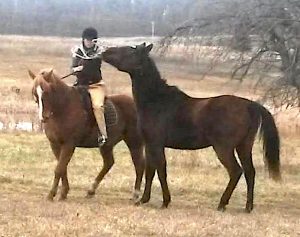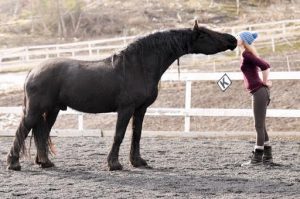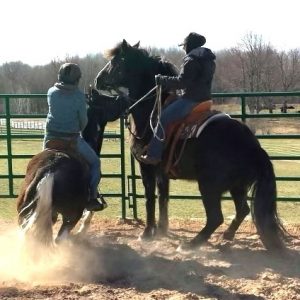Editor’s Note: Amy Skinner is a regular guest columnist and has been a horse gal since age six. She has presented twice at the Best Horse Practices Summit and is the author of To Catch a Horse: Finding the Heart of your Horsemanship.
She rides and teaches dressage and Western. Skinner has studied at the Royal Andalusian School of Equestrian Art in Spain, with Brent Graef, Leslie Desmond, and many others. Visit her website here.

Amy works with a crowding horse
Amy Skinner writes:
The Number One most common and dangerous issue I encounter daily?
Horses that crowd.
Horses that crowd are likely the most frustrated, stressed, and confused of horses. They receive endlessly conflicting messages when they are invited into the person’s space for treats and cuddles, only to be reprimanded when the person has had enough or starts to feel unsafe.
These kinds of horses may be invited into a space for a treat only to be later smacked in the face for being nosy. These horses are the same horses who are likely to receive excess pressure in being led, handled, and ridden. They are mislabeled as “friendly, gentle, full of personality” on one hand, and on the other hand “stubborn, rude, disrespectful,” depending on how things are going.
Their foundation is often traceable to the beginning of their lives. In breeding barns and backyards alike, excited owners make fast work of gentling a foal. Soon, the foal is not afraid of people and learns to enjoy affection from them. Foals quickly learn to push, nip, and play with a person as if they were a fellow young horse.
 Many breeding mares lack ideal socialization themselves. Motherhood is something horses learn from their mothers and other horses. Horses brought up in stalls, small pens, and dysfunctional herds fail to teach them ideal equine behavior. In an effort to protect their investment, many breeding barns keep horses isolated, and foals don’t grow up among a herd that will guide them, socialize them, and teach them what behaviors are acceptable and which are herds no-no’s.
Many breeding mares lack ideal socialization themselves. Motherhood is something horses learn from their mothers and other horses. Horses brought up in stalls, small pens, and dysfunctional herds fail to teach them ideal equine behavior. In an effort to protect their investment, many breeding barns keep horses isolated, and foals don’t grow up among a herd that will guide them, socialize them, and teach them what behaviors are acceptable and which are herds no-no’s.
Posturally-speaking, pushy horses develop tight shoulders, tight backs, and braces in their poll and necks. WHY? Since form follows function, their behavior actually makes it harder for them to yield away from you. Many horses that push on people drag on the lead rope, have front feet that are “stuck in the mud” when led forward or asked to move over. They become mentally and physically resistant. They are far more likely to have people fight with them, mislabel them as stubborn or disrespectful, and to struggle with training.
Horses with tight shoulders are more likely and more able to perform undesirable behaviors: bucking, rearing, bolting, sudden stopping, and running over people. Don’t forget that all these movements require and are made possible by weight on the shoulders. A tight mind (frustrated, anxious, bored, confused, distracted, or no longer interested) and tight body are a recipe for unfortunate times.
From a classical training perspective, I try my best not to teach postures on the ground that I wouldn’t want to ride.
From a behavior perspective, I try to look into all the pieces that make up the larger picture.
What you practice in the easy, quiet moments, you will then get in an amplified manner when things aren’t going well. Every “he doesn’t do this at home” is just a misunderstanding of what you’re actually doing at home. The smaller, less visible, at-home behavior, once out of the horse’s comfort zone, is now active in full tilt.
 Let me be clear:
Let me be clear:
- Your horse is not rude or disrespectful. He lacks a frontal lobe for such strategic thoughts. Your horse is doing what he knows how to do and what he is allowed or encouraged to do.
- Food or affection are not the problems. It’s the undisciplined manner in which these are doled out, with disregard or lack of understanding for the postural and behavioral poop storm that are sure to follow.
The kissing horse picture is a stock photo. The other two are horses I had in training who were described as “incredibly sweet and gentle.” In both scenarios, I asked the horse to move their shoulders to the side in non-confrontational way. One horse responded by trying to plow over me and my horse; the other went straight up.
Thanks, I really appreciate this article. About time it is understood. Long overdue.
Amy Skinner’ explains concepts without bias, projection and confusion. Her writing. Is some of the best out there for getting it right with your horse! Thanks Amy! Vital knowledge for keeping safe and enjoying all that horsemanship has to offer.
Good content that must be shared. Thanks Amy!